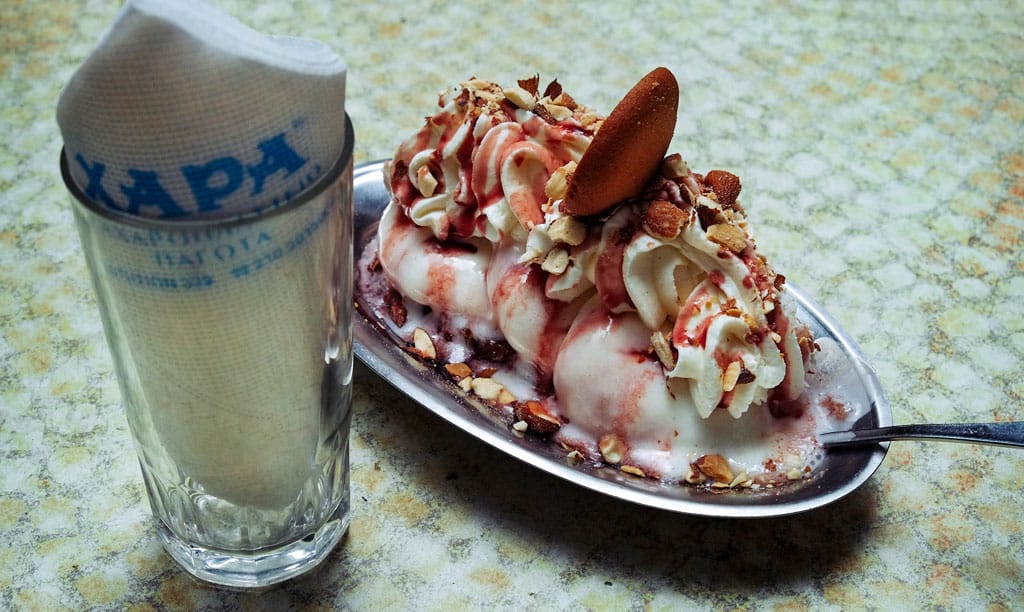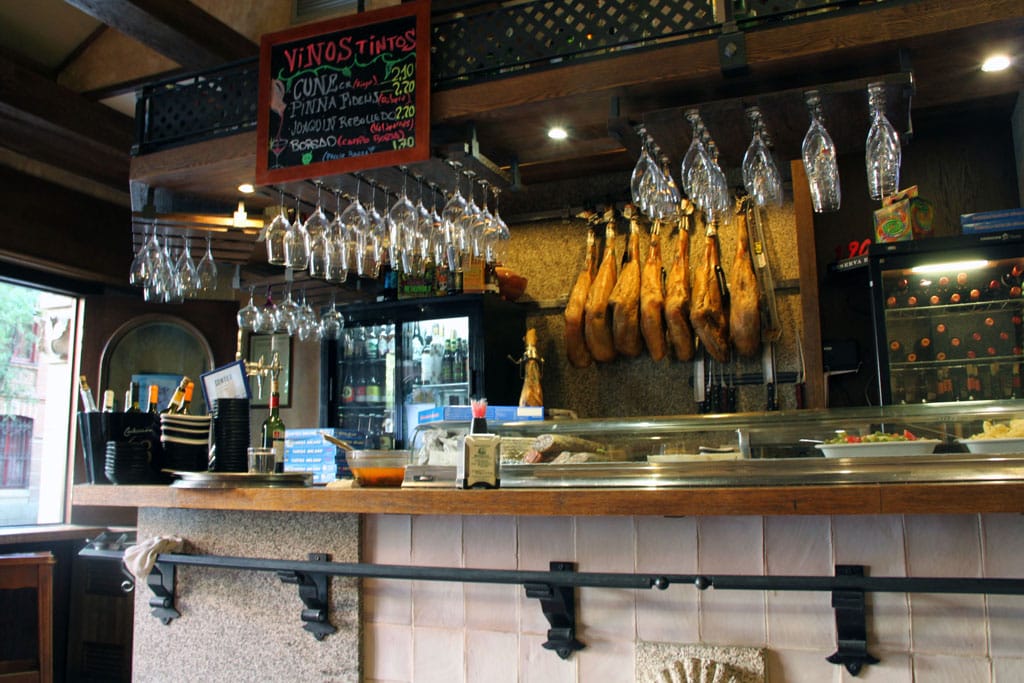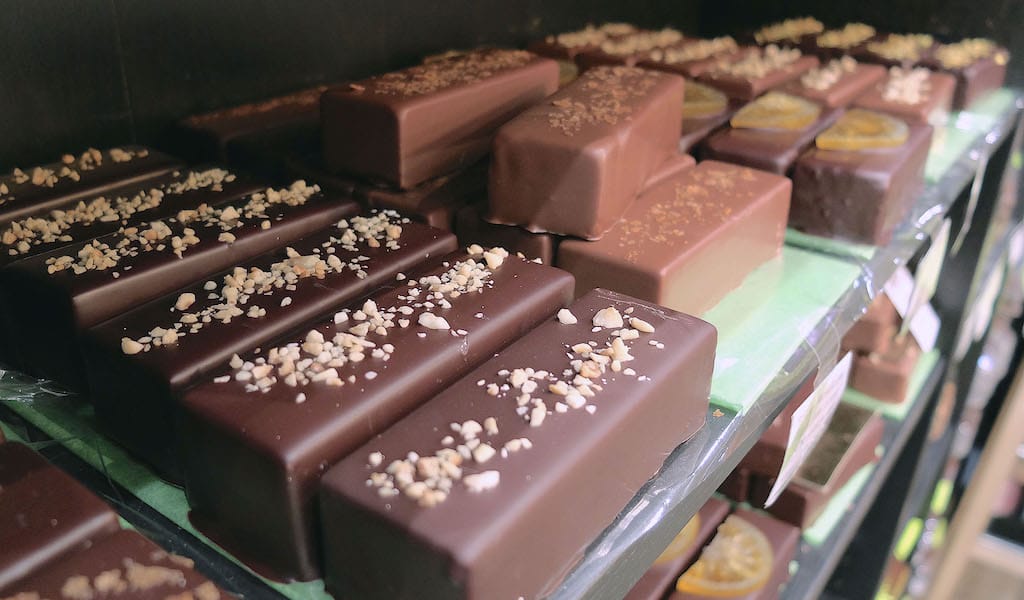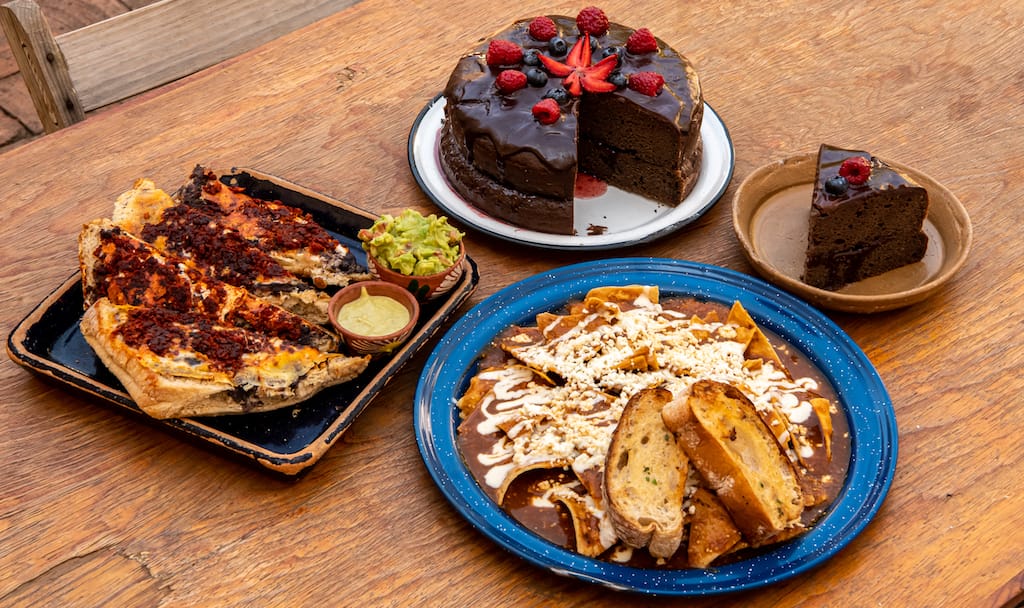Watching old Greek movies from the 1950s, ’60s and ’70s has been a rite of passage for every single generation raised in Greece from the ’80s onwards. When we were young, these movies played endlessly on TV, getting us acquainted with the Greece our parents grew up in.There were a number of things that both puzzled and delighted us – chief among them, the patisserie-as-meeting-place. The heroine, wearing a pillbox hat over expertly coiffed hair, would meet her girlfriends or potential love interest in grand-looking pastry shops, where she would be served by waiters in uniforms and eat a pasta, an individual portion of dessert: soft sponge cake with almond and cream or chocolate fillings.
The onscreen Athens centered on Patissia and Kypseli, neighborhoods which had already fallen from grace by the late ’80s, as their residents slowly abandoned them for the suburbs. Most films have a close-up of Patission Avenue, which connected Omonia Square to those neighborhoods. The street, whose official name is actually 28is Oktovriou, is home to some of Athens’ most important landmarks, including the National Archeological Museum and the Νational Technical University, and has undergone some dramatic changes in the past years. It is now a bit run-down, with a number of empty shops and buildings.
Xara (pronounced “Chara”) sits near the end of the avenue by the Ano Patissia suburban railway station. The shop opened in 1969, right when the golden era of the patisserie-as meeting-place concept was coming to an end.
 And yet, despite the fact that Athenians have long since abandoned patisseries as meeting points, Xara has remained a popular spot. The original owner, Xara, came from Istanbul and apparently carried the recipe for ekmek and kaymak in her shoe. Her family still owns the place. It looks like it’s stuck firmly in the ’80s, with its sepia glass walls, old-fashioned logo and an enormous brown catalog listing desserts such as Rocky, Coucou’s Nest, Maracaibo ice cream (milk chocolate with dark cherries) and Pasha ice cream (baklava ice cream with kaymak). The desserts often come in elaborate presentations. An ice cream we ordered came inside a glass with a base of floating penguins and was topped with an Italian flag! The shop started out offering “Istanbul-style” desserts but made its name selling two things: ekmek topped with kaymak ice cream, and a wonderful ice cream concoction called Chicago.
And yet, despite the fact that Athenians have long since abandoned patisseries as meeting points, Xara has remained a popular spot. The original owner, Xara, came from Istanbul and apparently carried the recipe for ekmek and kaymak in her shoe. Her family still owns the place. It looks like it’s stuck firmly in the ’80s, with its sepia glass walls, old-fashioned logo and an enormous brown catalog listing desserts such as Rocky, Coucou’s Nest, Maracaibo ice cream (milk chocolate with dark cherries) and Pasha ice cream (baklava ice cream with kaymak). The desserts often come in elaborate presentations. An ice cream we ordered came inside a glass with a base of floating penguins and was topped with an Italian flag! The shop started out offering “Istanbul-style” desserts but made its name selling two things: ekmek topped with kaymak ice cream, and a wonderful ice cream concoction called Chicago.
Ekmek varies widely depending on whether you are in Greece or Turkey. Xara’s ekmek is closer to the Turkish version, in which the bottom is essentially a bread pudding drenched in syrup and then topped with kaymak, a luscious clotted cream made from buffalo’s milk. In Greece the base is usually made with kataifi, the finely shredded phyllo widely used in desserts around the Middle East, and topped with whipped cream and pistachios or almonds. Xara offers six versions of ekmek, including the güzel ekmek (bread pudding base, buffalo clotted cream) and an ekmek with vanilla ice cream.
For the most popular version, the ekmek topped with kaimaki (the Greek name for kaymak) ice cream, Xara specifies on its menu that it uses ice cream made from buffalo milk. (Bear in mind that this is not always the case, as kaimaki ice cream in Greece is usually similar to Turkish dondurma in that it’s made with heavy cream, milk and sugar, as well as mastic and sahlep, a powder made from the root of wild orchids.) The base is almost chewy with sweet syrup and is complemented perfectly by the rich, slippery ice cream. It’s a masterpiece. And at €7.50, it’s also a pricey dessert by Athenian standards.
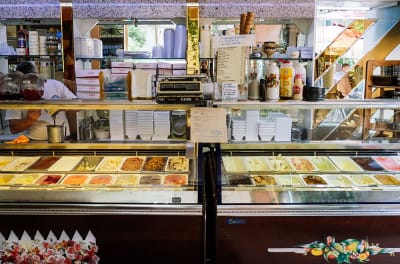 The Chicago is a nostalgic classic loved by children, combining chocolate ice cream with whipped cream, chocolate sauce and chopped almonds on top. It’s a chocoholic’s dream – and is even better when the ice cream begins to melt and pools into the chocolate sauce.
The Chicago is a nostalgic classic loved by children, combining chocolate ice cream with whipped cream, chocolate sauce and chopped almonds on top. It’s a chocoholic’s dream – and is even better when the ice cream begins to melt and pools into the chocolate sauce.
Although much of the Athens in those old movies has long disappeared, Xara has survived, doing what it has always done. So grab your pillbox hat – we’ll see you there.
This story was originally published on July 30, 2014.
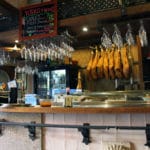 January 17, 2017 O Pazo de Lugo
January 17, 2017 O Pazo de Lugo
Galician restaurants have had a strong presence in Madrid since the 1950s, when the […] Posted in Madrid December 4, 2020 La Chocolatière de Marseille
December 4, 2020 La Chocolatière de Marseille
When we first moved to Marseille, a jewel box of a shop caught our eye while wandering […] Posted in Marseille April 11, 2024 Oscuro Brebaje
April 11, 2024 Oscuro Brebaje
As difficult as the last two years have been for food businesses, it has offered many […] Posted in Oaxaca
Published on August 03, 2016
Related stories
January 17, 2017
MadridGalician restaurants have had a strong presence in Madrid since the 1950s, when the northwestern region’s economic crisis triggered a solid exodus of people towards industrial Spanish cities. This migratory wave, alongside the fact that Galician gastronomy was (and still is) considered one of the best in the country, meant a boom of new restaurants…
December 4, 2020
MarseilleWhen we first moved to Marseille, a jewel box of a shop caught our eye while wandering around the Vieux-Port. Its window display was stacked with chocolates: smooth rectangular bars, green and brown olivettes (chocolate-covered almonds) and slabs studded with every kind of nut. When a customer opened the door to leave, the strong scent…
April 11, 2024
OaxacaAs difficult as the last two years have been for food businesses, it has offered many establishments an opportunity to rethink how they do things and come back with a greater sense of purpose. Take the example of Oaxaca’s Oscuro Brebaje, a café that took a pause, only to emerge stronger and more inviting. Founded…







































